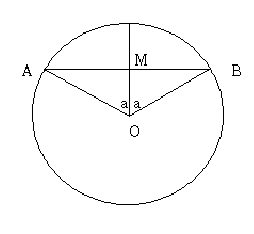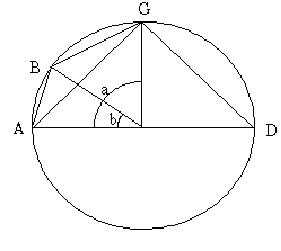
 Note that AD is a diameter of the circle.
Note that AD is a diameter of the circle.
II.6 If a straight line be bisected and a straight line be added to it in a straight line, the rectangle contained by the whole with the added straight line and the added straight line together with the square on the half is equal to the square on the straight line made up of the half and the added straight line.
(This was in the "Geometric Algebra" homework!)
I.47 Pythagorean Theorem
VI. Def. 2 (Note typo on bottom left of page 168, Def. 3 is cited by mistake)
A straight line is said to have been cut in extreme and mean ratio when, as the whole line is to the greater segment, so the greater is to the less.
XIII. 9 If the side of the hexagon and that of the decagon inscribed in the same circle be added together, the whole straight line has been cut in extreme and mean ratio, and its greater segment is the side of the hexagon.
IV. 15 Corollary If in a given circle an equilateral and equiangular hexagon is inscribed, the side of the hexagon is equal to the radius of the circle.
XIII. 10 If an equilateral pentagon be inscribed in a circle, the square on the side of the pentagon is equal to the squares on the side of the hexagon and on that of the decagon inscribed in the same circle.
III. 21 In a circle the angles in the same segment are equal to one another.
VI. 4 In equiangular triangles the sides about the equal angles are proportional, and those are corresponding sides which subtend the equal angles.
VI. 6 If two triangles have one angle equal to one angle and the sides about the equal angles proportional, the triangles will be equiangular and will have those angles equal which the corresponding sides subtend.
Regiomontanus Reading

 Note that AD is a diameter of the circle.
Note that AD is a diameter of the circle.
![]() A pdf version of this page and the accompanying reading assignment.
A pdf version of this page and the accompanying reading assignment.
Go back to course home page
Go back to
my home page.